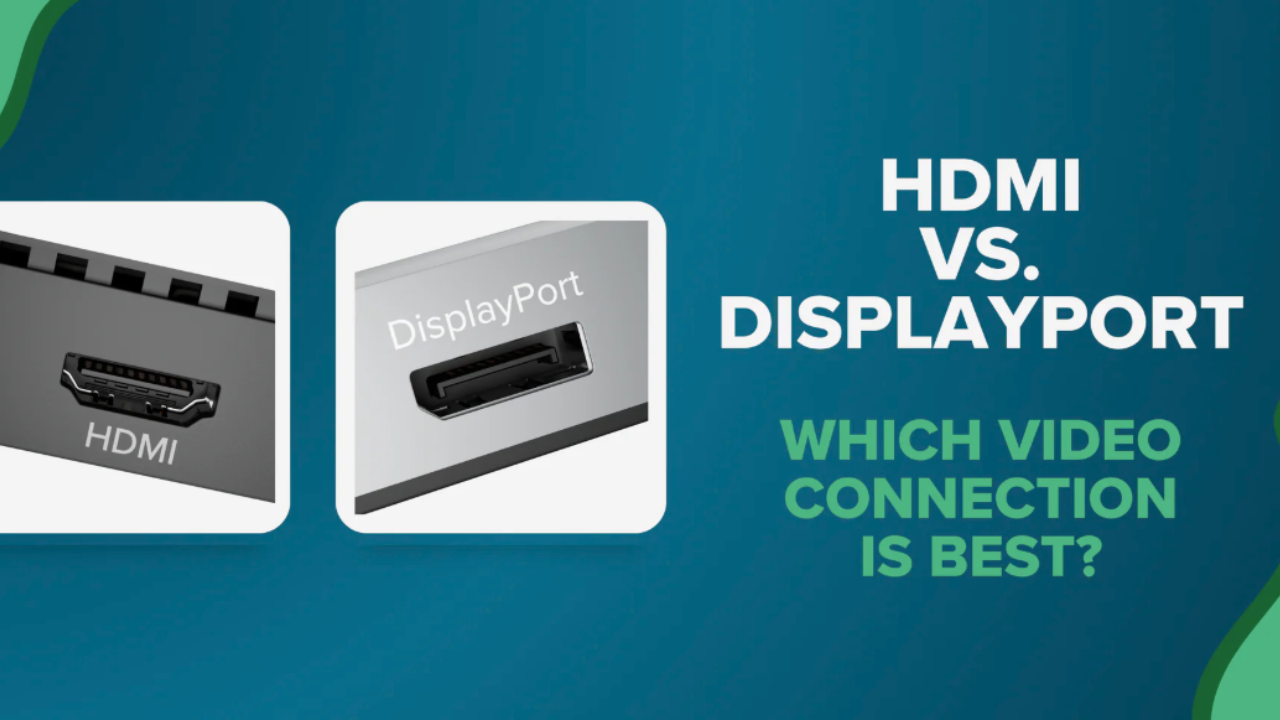HDMI vs. DisplayPort: Which Video Connection is Best?
Product Owners | July 20, 2025

Whether you're building a multi-monitor workstation, gearing up for 4K gaming, or connecting your laptop to a conference room projector, choosing the right video connection is essential. HDMI and DisplayPort are the two most common and modern options out there. If you've ever wondered, "Which one should I use?", we’ve got it covered.
Let’s break down the differences between HDMI and DisplayPort, highlight when each one shines, and help you choose the right one for your setup.
Note: As of the writing of this blog, we are speaking to the current, most modern, and prevalent HDMI and DP versions. That is HDMI 2.0 and 2.1, DisplayPort 1.4 and 2.1.
HDMI: The Household Favorite
HDMI (High-Definition Multimedia Interface) is practically everywhere. From TVs and soundbars to gaming consoles and laptops. It’s designed to carry both audio and video over a single cable, which makes it super convenient.
Key HDMI 2.1 Features:
- Resolution Support: Up to 8K at 60Hz, 4K at 120Hz.
- Dynamic HDR: Brings richer color and contrast, especially for movies and gaming.
- Variable Refresh Rate (VRR): Reduces screen tearing during fast-action scenes or gameplay.
- High-End Audio: Supports Dolby Atmos and DTS:X for immersive surround sound.
Key HDMI 2.0 Features:
- Resolution Support: Up to 4K at 60Hz
- Bandwidth: Up to 18 Gbps
- Audio and Video Over One Cable: Transmits both sound and video through a single HDMI cable
- Chroma Subsampling: Supports 4:4:4 color at 4K for sharp text and detailed visuals
HDMI is especially common in living room setups and professional AV environments. You’ll find HDMI ports on most TVs, projectors, and consumer electronics, making it a reliable all-rounder.
DisplayPort: Built for Performance
DisplayPort, originally developed for PCs, takes a performance-first approach. It's a favorite among gamers, creative professionals, and anyone who uses high-resolution, high-refresh-rate displays. Additionally, high-end features like Multi-Stream Transport (MST) is an advanced feature that allows for easy and seamless multi-monitor setups on PCs (unfortunately, macOS does not support MST.
Key DisplayPort 2.1 Features:
- Resolution Support: Up to 16K at 60Hz or 8K at 120Hz (with Display Stream Compression)
- Bandwidth: Up to 80 Gbps using UHBR20 (Ultra-High Bit Rate) mode
- Display Stream Compression (DSC) 1.2a: Enables ultra-high resolutions and refresh rates with minimal visual loss
- Backward Compatibility: Fully supports older versions of DisplayPort for seamless device integration
DisplayPort is often the go-to choice for professional monitors, gaming PCs, and USB-C docking stations, where multiple screens or ultra-high resolutions are needed.
Key Features: DisplayPort 1.4
- Resolution Support: Up to 8K at 60Hz (with Display Stream Compression), 4K at 120Hz
- Bandwidth: Up to 32.4 Gbps with HBR3
- HDR10 Support: Allows high dynamic range visuals for better contrast and color
USB-C and Thunderbolt: Where Do They Fit?
While HDMI and DisplayPort are the main video connectors, USB-C and Thunderbolt are becoming more ubiquitous because of their inclusion in modern laptops and devices for video, which are called USB-C DisplayPort Alternate Mode (DP Alt Mode). This means that a DisplayPort signal can be transferred over USB-C connections rather than just the larger DisplayPort connector.
If your computer’s USB-C ports are based on Thunderbolt or are fully-featured USB-C ports, USB-C to HDMI or USB-C to DisplayPort adapters (like our USBC-HDMI-CABLE, USBC-DP cable or USBC-TDP adapter) and cables can be used in order to connect to your displays if they do not have USB-C or Thunderbolt input ports.
HDMI vs. DisplayPort: Head-to-Head Comparison
| Feature | HDMI 2.0 | HDMI 2.1 | DP 1.4 | DP 2.1 |
|---|---|---|---|---|
| Max Resolution | 4K @ 60Hz | 8K @ 60Hz | 8K @ 60Hz* | 16K @ 60Hz* |
| Max Bandwidth | 18 Gbps | 48 Gbps | 32.4 Gbps | 80 Gbps |
| HDR Support | Static | Dynamic HDR | HDR10 | Yes |
| VRR / Adaptive Sync | Limited | Yes | Yes | Yes |
| MST Support | No | No | Yes | Yes |
Use Cases: When to Use HDMI or DisplayPort
Gaming
- Console Gaming (Xbox, PlayStation, Nintendo Switch):
Stick with HDMI. Consoles and TVs are optimized for HDMI. Also, HDMI ports on a console won’t be able to work with a display that has DisplayPort without the use of specialized active adapters. - PC Gaming:
Use DisplayPort. With greater bandwidth, DisplayPort supports performance resolutions and refresh rates for smoother gameplay.
Creative Professionals
- Graphic Design, Video Editing, 3D Modeling:
Opt for DisplayPort, especially DP 1.4 or 2.1, for high-resolution, color-accurate displays. Many professional monitors support 10-bit color, HDR, and wide gamuts best delivered through DisplayPort. - Plugable Tip: If your laptop has a Thunderbolt port, a DisplayPort-equipped docking station like the TBT4-UDZ to power ultrawide or 4K monitors for performant setups
Productivity & Office Work
- Multiple Monitor Setups for Everyday Office Tasks (Email, Docs, Web):
For general productivity, both HDMI and DisplayPort will get the job done. Choose based on your available ports, display inputs, and whether you prefer a simple adapter or a full docking station. If your laptop supports a fully featured USB-C with DisplayPort Alt Mode, DisplayPort via MST-enabled docks (like the UD-MSTH2) offers efficient multi-monitor support with minimal setup.
However, not all systems have that capability, especially older laptops or those limited to USB 3.0 Type-A ports. That’s where DisplayLink-based docking stations come in. These use USB graphics technology to drive multiple displays, even when native video output is limited. - Plugable Picks:
- USB-C systems: Use hybrid docks like the UD-3900C4 for up to four displays
- USB-A systems: Use UD-6950Z or USBC-6950U for dual display with HDMI or DisplayPort support, depending on the resolutions and connections you need
Plugable Tip: DisplayLink solutions are great for hot-desking or hybrid work environments, they’re flexible, driver-supported, and work across a wide range of laptops.
Conference Rooms & Presentations
- Projectors and TVs:
Use HDMI for maximum compatibility. Most conference rooms are built around HDMI inputs, making it the safe and reliable choice. - Plugable Tip: For USB-C laptops, our USBC-HDMI adapter, USBC-MSTH2, or hybrid docks like the UD-3900PDZ make presenting easy.
Which Should You Choose?
If compatibility is key, especially with TVs, AV receivers, or projectors, HDMI is your safest bet. But if you’re pushing pixels for professional or gaming reasons, DisplayPort often offers more bandwidth, features, and flexibility.
And if you’re still not sure? Plugable’s support team is just an email away at support@plugable.com. Whether you're wiring up a hybrid work setup or just want to know what cable gets the most from your shiny new monitor, we’re here to help.
View Other Articles in Category
Related Articles


Loading Comments